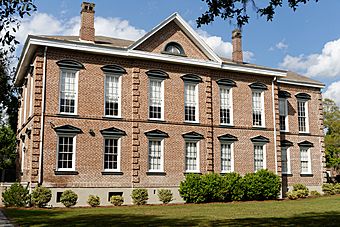Bethesda Academy facts for kids
Quick facts for kids |
|
|
Bethesda Academy
|
|
 |
|
| Nearest city | Savannah, Georgia |
|---|---|
| Area | 650 acres (260 ha) |
| Built | 1870 |
| Architectural style | Classical Revival |
| Website | Bethesda Academy |
| NRHP reference No. | 73000614 |
| Added to NRHP | September 12, 1973 |
Bethesda Academy is a special school for boys located near Savannah, Georgia. It used to be known as Bethesda Home for Boys and was once an orphanage. Its main building is very old and was added to the National Register of Historic Places in 1973.
Contents
History of Bethesda Academy
How Bethesda Started
Bethesda was founded in 1740 by a religious leader named George Whitefield. He started it as an orphanage for boys. It was built on a large piece of land about 10 miles (16 km) south of Savannah, Georgia. Whitefield named it Bethesda, which means "House of Mercy." He hoped it would be a place where many kind acts would happen.
Construction on the orphanage began on March 25, 1740. The main building had two stories and twenty rooms. There were also two smaller buildings. One was for sick children, and the other was a place for them to work.
Education and Challenges
Whitefield wanted the orphanage to teach boys strong values and good discipline. Boys learned useful skills and trades. This helped them earn a living when they grew up. Younger children learned spinning and carding. All the boys were taught mechanics and farming. Whitefield even hoped Bethesda would become a university one day.
Even though the children grew most of their own food, running the orphanage was very expensive. Whitefield faced many debts. A famous person named Benjamin Franklin suggested moving the orphanage. He thought it might be easier to run in Philadelphia. But Whitefield refused because people had donated money specifically for the Georgia project.
Changes Over Time
When Whitefield passed away, he left the orphanage to Selina Hastings, Countess of Huntingdon. She was a kind person in England who supported charities. Whitefield asked her to keep the orphanage going and to start a college there. However, it was hard for her to manage the orphanage from so far away. Because of this, Bethesda almost had to close.
In 1773, a big fire destroyed the main building. A few years later, the American Revolution made it impossible to build the college. After some changes in how it was managed, a new building was built. The Bethesda Home for Boys was then officially started on the same land.
Bethesda and Slavery
In the early 1700s, slavery was actually against the law in Georgia. However, in 1749, George Whitefield argued that slavery should be allowed. He believed that farms in Georgia would not be successful without it. He felt that allowing slavery was necessary to make his own farm profitable.
Partly because of his efforts, slavery became legal again in Georgia in 1751. After this, Whitefield bought enslaved people to work at Bethesda Orphanage. He also used enslaved people at his other property, Providence Plantation. This helped him raise money for the orphanage. When Whitefield died, he left these enslaved people to the Countess of Huntingdon.
Bethesda Today
Bethesda has not been an orphanage for many years. Today, it focuses on helping young people in the Savannah area. Bethesda is now a private school for boys in grades 6 through 12. Students can live at the school or attend during the day.
In April 2011, the Bethesda Home for Boys changed its name. It became Bethesda Academy. This new name better shows its goal of educating young men. In 2015, Bethesda celebrated its 275th anniversary.



